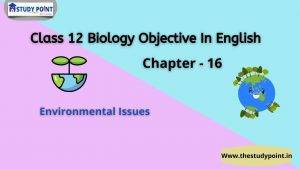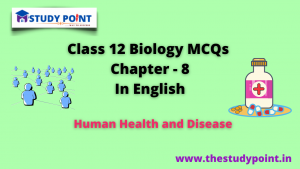Here we are providing Class 12 Biology Objective In English Chapter – 10 Microbes in Human Welfare include all questions presented in the Biology Class 12 books. Candidates can enlist the help of the Biology Class 12 Objective in English on the next page and gain a deeper understanding of the concepts. Class 12 Biology Objective in English Chapter – 10 Microbes in Human Welfare is designed by our team of subject matter experts to help students prepare for exams. English students can view the PDF of the Class 12 Biology Objective on the page below. From the Biology Book English Questions and Answers on this page, students will learn how to correctly solve problems.
Remember that the Class 12 Biology Book Objective is the best resource for a good study of the 16 chapters. Use the Class 12 Biology Book Objective as a reference and keep practicing with the answers to questions and exercises until you improve your answers to all chapters of your Class 12 Biology Program. Class 12 Biology Objective in English Chapter – 10 Microbes in Human Welfare will help you solve all Class 12 Biology questions chapter 10 smoothly. if you want more notes for various subject then click here
Class 12 Biology Objective In English Chapter – 10 Microbes in Human Welfare
1. Brewery is connected with
( A ) Saccharomyces
( B ) Protozoans
( C ) Pteridophytes
( D ) Marsupials
Ans-( A )
2. For Nitrogen fixation in soil we may use
( A ) Cyanobacteria
( B ) Protozoans
( C ) Nematodes
( D ) Wheat plants
Ans-( A )
3. Which of the following antibiotics was extensively used to treat american soldiers wounded in world war II.
( A ) Neomycin
( B ) Bacitracin
( C ) Chloramphenicol
( D ) Penicillin
Ans-( D )
4. Probiotics are :
( A ) New kind of food allergens.
( B ) Safe antibiotics
( C ) Live microbial food supplement
( D ) Cancer inducing microbes
Ans-( C )
5. Organic farming does not include
( A ) green manures
( B ) chemical fertilizers
( C ) farmyard manures
( D ) compost
Ans-( B )
6. Farmers have reported 50% higher rice yield by the use of biofertilizers?
( A ) Bacillus thuringiensis
( B ) Rhizobium
( C ) Mycorrhizae
( D ) Azolla pinnata
Ans-( D )
7. Third generation pesticides are :
( A ) Insect repellants
( B ) Pheromones
( C ) Pathogens
( D ) Insect hormone analognes
Ans-( D )
8. Which of the following can cause molecular nitrogen as nutrient ?
( A ) Methanomonas
( B ) Mucor
( C ) Rhizobium
( D ) Spirogyra
Ans-( C )
9. Industrial production of ethanol fromstarch is brought about by a certain species of :
( A ) Penicillin
( B ) Azotobacter
( C ) Saccharomyces
( D ) Lactobacillus
Ans-( C )
10. Process of biogas production is :
( A ) aerobic
( B ) anaerobic
( C ) active process
( D ) passive process
Ans-( B )
11. Which of the following is not biofertilizer ?
( A ) Azotobacter
( B ) Bacillus thuringiensis
( C ) Clostridium
( D ) Azolla
Ans-( B )
12. Masses of bacteria associated with fungal filament to form a mesh like structure is called :
( A ) Flocs
( B ) Methanogen
( C ) Plasminogen
( D ) None of these
Ans-( A )
13. The toxic protein secreted by Bacillus thuringiensis is:
( A ) Tubulin
( B ) Insulin
( C ) Cry protein
( D ) All
Ans-( C )
14. Which of the following is a retro virus?
( A ) Human Immuno Deficienyc virus
( B ) Hepatitis virus
( C ) Microvirus Influenzil
( D ) All of these
Ans-( A )
15. Which microbe is useful in the formation of curd from milk ?
( A ) Clostridium
( B ) Lactobacillus
( C ) Both (A) and (B)
( D ) Streptococcus
Ans-( B )
16. The flour of Idli & Dosa is made by the use of which microbe ?
( A ) Bacteria
( B ) Lactobacillus
( C ) Virus
( D ) Yeast
Ans-( A )
17. Which one of the following is helpful in the improvement of soil ?
( A ) Insecticide
( B ) Biofertilizer
( C ) Yeast
( D ) None of these
Ans-( B )
18. Aquatic fern which is an excellent biofertilizer :
( A ) Salvinia
( B ) Azolla
( C ) Marsellia
( D ) Pteridium
Ans-( B )
19. Which of the following microbes is a proteinaceous infectious agents ?
( A ) Fungi
( B ) Prions
( C ) Bacteria
( D ) Protozoa
Ans-( B )
20.Cyanobacteria are :
( A ) heterotrophs
( B ) chemotrophs
( C ) autotrophs
( D ) organotrophs
Ans-( C )
21. The chemicals produced by some microbes to kill or retard the growth of other microbes are called :
( A ) antiseptics
( B ) antacid
( C ) antibiotics
( D ) all
Ans-( C )
22. Which of the following was an accidental discovery ?
( A ) Penicillin
( B ) Insulin
( C ) Chloramphenicol
( D ) DNA
Ans-( A )
23 Sour taste of vinegar is due to :
( A ) Lactic acid
( B ) acetic acid
( C ) butyric acid
( D ) fumaric acid
Ans-( B )
24. Which one is biofertilizer ?
( A ) Mycorrhiza
( B ) Nitrogen fixing bacteria
( C ) Nitrogen fixing cyanobacteria
( D ) All the above
Ans-( D )
25. Some blue green algae are used as biofertiliser because they can:
( A ) Fix nitrogen
( B ) Secrete nuclilage
( C ) Perform photosynthesis
( D ) Grow everywhere
Ans-( A )
26. An insect repellent neem product is :
( A ) Rotenone
( B ) Azadirachtin
( C ) Parathion
( D ) Endrin
Ans-( B )
27. Bt cotton is resistant to :
( A ) Insects
( B ) Herbicides
( C ) Salt
( D ) Drought
Ans-( A )
28. The process of increasing soil fertility by earth worms is
( A ) Worm casting
( B ) Vermi composting
( C ) Compost bedding
( D ) None of these
Ans-( B )
29. In gobar gas maximum amount is that of :
( A ) Propane
( B ) Methane
( C ) Butane
( D ) CO2
Ans-( B )
30. Which of the following step is taken by Govt. of India to protect rivers from water pollution ?
( A ) Ganga action plan
( B ) Narmada action plan
( C ) Yamuna action plan
( D ) Both (A) and (C)
Ans-( D )
31. Bacteria present in the rumen of cattle is :
( A ) Azotobacter
( B ) Rhizobium
( C ) Methanobacterium
( D ) Azospirillum
Ans-( C )
32. In the sewage treatement, bacterial of are allowed to sediment in a settling tank. This sediment is called :
( A ) inactivated sludge
( B ) activated sludge
( C ) primary sludge
( D ) secondary sludge
Ans-( B )
33. During primary treatment of sewage solid particles that settle down are called
( A ) flocs
( B ) primary sludge
( C ) activated sludge
( D )anaerobic sludge
Ans-( B )
34. Which of the following organism is used in the production of beverages?
( A ) Penicillium notatum
( B ) sacharomyces cerevisac
( C ) Aspergillus niger
( D ) Clostridium butylicum
Ans-( B )
35. ‘Yeast’ is an important source of :
( A ) Vitamin C
( B ) riboflavin
( C ) Sugars
( D ) Proteins
Ans-( B )
36. Formation of vinegar from alcohol is caused by :
( A ) Bacillus subtilis
( B ) Clostridium
( C ) Acetobacter aceti
( D ) Azotobacter
Ans-( C )
37. The bacterium capable of anaerobic N2-fixation is known as:
( A ) Azotobacter
( B ) Clostridium
( C ) Bacillus
( D ) Rhizobium
Ans-( B )
38. The symbiotic association between fungi and roots of higher plants is called :
( A ) Lichen
( B ) mycorrhiza
( C ) biofertilizer
( D ) biocontrol agent
Ans-( B )
39. Statins used for lowering blood-cholesterol level are extracted from:
( A ) algae
( B ) bacteria
( C ) viruses
( D ) yeasts
Ans-( D )
40. Which is the first step of sewage treatment
( A ) Precipitation
( B ) Chlorination
( C ) Sedimentation
( D ) Aeration
Ans-( C )
41. Integrated Pest management discourages the excessive use of :
( A ) biological methods
( B ) chemical pesticides
( C ) mechanical methods
( D ) All
Ans-( B )
42. Which in the following is a non- symbiotic biofertilizer?
( A ) VAM
( B ) Azotobacter
( C ) Anabaena
( D ) Rhizobium
Ans-( B )
43. Bacillus thuringiensis is used to control
( A ) bacterial pathogens
( B ) fungal pathogens
(C ) nematodes
( D) insect pests
Ans-( D )
44. Which is widely used successful biofertilizer in Indian rice fields ?
( A ) Rhizobium
( B ) Acacia
( C ) Acalypha
( D ) Azolla
Ans-( D )
45. N2-fixation in root nodules of almus is brought about by
( A ) Frankia
( B ) Azorhizobium
( C ) Bradyrhizobium
( D ) Clostridium
Ans-( A )
46. Name the fungus used for steroid synthesis ?
( A ) Aspergillus oryzae
( B ) Torulopsis utilis
( C ) Rhizopus stolonifer
( D ) Neurospora cross
Ans-( C )
47. A major component of gobar gas is :
( A ) butane
( B ) ammonia
( C ) methane
( D ) ethane
Ans-( C )
48. Baker’s yeast in the following is :
( A ) S.Cerevisae
( B ) S.ludwingia
( C ) S.Octosporus
( D ) Sehizosaccharomyces
Ans-( A )
49. Most commonly used green manures in India are :
( A ) Crotolaria Juncea
( B ) Sesabaria aculeata
( C ) Cyamopsis tetragonoloba
( D ) All
Ans-( D )
50. Which one is not used as a biopesticide?
( A ) Trichoderma harzianum
( B ) Nucleopolyhedrovirus
( C ) Xanthomonas campestris
( D ) Bacillus thuringiensis
Ans-( C )
51. Streptomycin is obtained from :
( A ) Streptomyces griseus
( B ) S. cerevisae
( C ) S. venezuelae
( D ) S. ramosus
Ans-( B )




